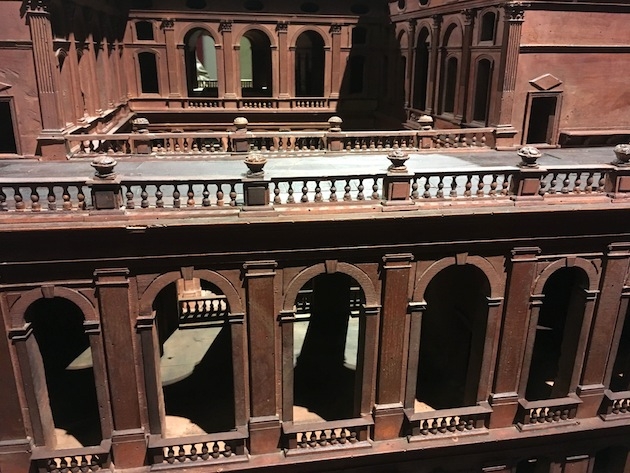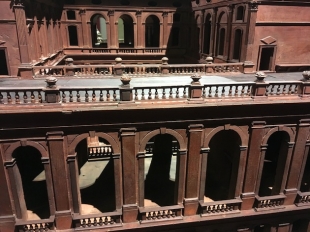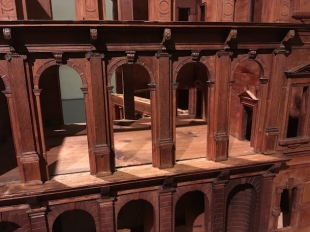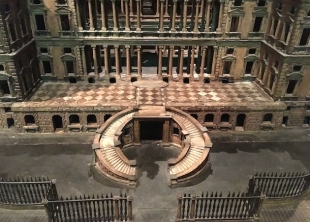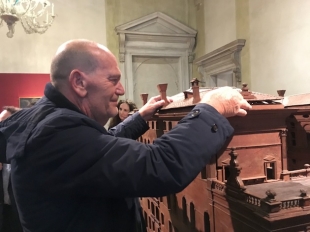» archive blog
-
Carnal, issue 0 of Parterre de Rois
A new magazine in Milandate: 18-07-2013
-
Interview with Nicola Toffolini
A worlds inventordate: 24-04-2011
-
Donne senza uomini.
Installazione multimediale di Shirin Neshatdate: 01-03-2011
Venice Patrons saved six large scale wooden architecture models
Vuitton helps MUVE for the sixth time and tell us the company relation with contemporary art
Since six years it happens and luckily it will be not the last one. A very important luxury group (LVMH) with its main company (Louis Vuitton) saves and valorise the Venetian patrimony of the main Foundation managing the council museums of the city on the water: MUVE with its 12 venues and their collections plus few other books and drawings funds. This time Vuitton helped to save six incredible wooden working plan maquette of six architectures (two, above the others, are Villa Pisani in Stra and the Palazzo Venier in Venice: actually its incomplete building is the house of Peggy Guggenheim). Salvaged by the archives and by the oblivion, these gigantic models are exhibited in two MUVE museums: the main one, Correr, and my favourite, Fortuny where the incredible contemporary art exhibition Quand fondra la neige où ira le blanc has been extended until November 6.
The maquettes have been not only saved (outside and inside, as the restorer Stefano Provinciali outilined: especially for Palazzo Venier, there are intarsio and special features not only on the facades but also inside where every interior decoration has been detailed for the building phase, from the plaster frames on the walls to the staircases: do not forget to look also in it!). These architectural models have been given back to the audience by allowing us to read the patina of the times; the furious addictions in the course of their lives, the subtractions and what is lacking (even if the restoration team was able to detect and to unify in the right place the thousands of fragments the museum curators gave to them at the beginning). They also were given back to get their function: they’re not just decorative amenities but ‘heavy’ working objects that were brought in the construction sites as we now bring drawings on paper: some of them (as Villa Pisani one at Fortuny) were made of recovered timbers and were having handles to be carried here and there beside to be built in sections so each can be detached accordingly to the site needs. They’re made to be durable given that the average life of a construction site at those times was of more than thirty years and they’ve been not surviving if made differently. If not saved now, they would have been forgotten and subtracted to our admiration.
‘It is not the first time Vuitton collaborates to the conservation, to the restoration and to valorise works of art (and, further, of venues) owned by Fondazione Musei Civici’ Daniela Ferretti, Fortuny director tells (she is already at work on the next exhibit, after having won a quite considerable prize with the previous one, Proportio on the golden rule in arts and architecture: she reveals that the theme will be, next time, the intuition).
‘What maybe you do not know is that they work by preferring the less known, the less easy and the less obvious – for instance, here at Fortuny they helped us also to restore Fortuny’s movies, a very expensive and not easy task’
Christine Vendredi-Auzannau, Tokyo Espace Vuitton director and, more important, since two years director of Art and Culture section of Fondation Vuitton (and of the group), is arrived today in Venice to open the two exhibits and to discus with Gabriella Belli of the next steps to undertake together (especially for the Art Biennale next year). She was just returning from the Munich Espace.
Further to consider as a privileged one the relation with MUVE that has to be continued, she told something more about their relation with the ‘contemporary’ in arts. First, that the sector stays very crucial for the Maison and even more for the fact that the Espaces (beside Venice, Tokyo and Munich, also Beijing) exhibit unique projects that have never been before in France even if they come from the Arnault’s art collection. It is exactly in places like the Espaces they can work by showing more pieces by a same artist and by working with the method she proposed: the accrochage. Mixing, so, contemporary and antique works.
She also tells that ‘antique’ means first of all safeguard, restoration and the act of giving it back to the territory where the Espace is set (in Venice it’s on the last storey of the Vuitton shop in Calle del Ridotto, San Marco). Following this aim, the last projects varied for instance from mixing the optic landscape views of XVIth Century (belonging to MUVE) and a small but powerful Olafur Eliasson’s installation; from the restoration of XVIIIth Century garments that have been put beside to the fragmented visions of a contemporary artist and performer from Hong Kong, Movana Chen, who creates garments by knitting recycled paper strips (the ones for this show were coming from the cutting of old Vuitton’s catalogues).
By asking if there were ‘frictions’ in the fruition of their proposals in contemporary culture in town now that a new space opened (Fondaco dei Tedeschi where a retail company of the group, DHS, is managing the building that has also exhibition spaces: at the top and on the bottom level) that will program events all the year long (the actual manager of this space is
Delphine Trouillard, former Pinault Fondation communication manager, the other big player of contemporary art in Italy and in Venice: Auzannau and Trouillard will meet up next week in France).
Many restorations financed by Vuitton (and already finished) have not yet been revealed by MUVE, for them is more important to concentrate on what is to be done rather than to communicate it: this can happen in a second moment (Auzannau also tells that is Ms Belli to inform her about the priorities in restoration – doesn’t matter if venue or artworks or artefacts as in this case).
This tranche of restorations has been presented for two main reasons.
The first is because Espace Vuitton hosts the exhibit (extended until February 26, 2017) of the architectural models by Gehry for his building of the Fondation Vuitton, so the double exhibit of the maquettes is recalling it and the Espace is just between the two museums (as Ferretti told, is just a short walk to run – unfortunately it’s the most crowded area by mass tourists).
The second, I read it, is also dictated to present a coherent theme with the second part, and more fruitful one, of the Architecture Biennial. The first part has been less visited due to the fear of bombings and to the European Football tournament. Of course, it has to be said that the new duration of this exhibit is just a recent thing, going back to when Rem Koolhaas, the rumoured Fondaco’s architect – rebranded the show since he was its director, two years ago.

